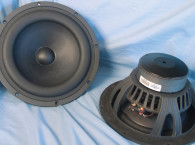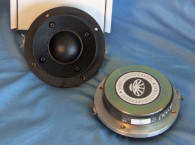


While we are on the subject of the VM752 and VM527 dome mids, Volt asked me to add the following feature clarification for the two dome midrange drivers that did not make it into the original reviews: The VM752 uses a single layer, round wire copper coil slightly longer than the focused magnet gap to allow for high excursions at the lower end of its operating range. This mid dome also uses a single piece dome with two surrounds for high power handling and stability along with a Kapton/Kraft sleeve voice coil, while the 2” VM527 mid dome uses a single-piece dome/surround along with a Nomex/Kapton voice coil.
As for the subject of this explication, the Volt RV3143 12” studio monitor woofer is probably the most uniquely designed woofer to come across my desk in a while. Looking at Photo 1, it is obvious there is something different about the Volt RV3143 — there is no frame on the back side of the driver!
Volt’s patented Radial Technology is the brain child of the company’s founder, David Lyth. Lyth has had a fascinating career in the development of British loudspeakers. After graduating with a degree in electronics, he received an MSc in Applied Acoustics from London University specializing in servo-controlled loudspeaker systems. Lyth then worked at Jordan Watts of Hayes, Middlesex, which manufactured full-range aluminum cone loudspeaker units and systems. He was also employed by Gale Electronics as QC manager and lead production for its well-known black and chrome loudspeaker system. Still overseeing production, Lyth moved to Martin Audio where he worked closely with Dave Martin in a technical capacity. Before starting Volt, Lyth completed six months with Sanyo designing domestic systems and advising on its UK manufacture.
Now with a wealth of commercial experience, Lyth leased a small space from his first employer, Jordan Watts, and Volt Loudspeakers was born — the rest is history. A highly respected figure in the audio industry, Lyth now focuses on providing design assistance to existing customers and using his extensive knowledge and expertise to complete bespoke systems.


Looking at Figure 1, you can observe that the Volt Radial Technology consists of a front-mounted eight-spoke proprietary cast aluminum frame that is mechanically coupled to both the back plate and to the top of the pole structure/phase plug, in contrast to a normal rear frame that is only coupled to the motor front plate. This not only has greater mechanical coupling to the major heat conducting elements of the motor structure, but much of the heat produced by the motor is being radiated to the air outside the enclosure rather than heating the air within the enclosure.
Additional cooling to the front plate is provided by a rather substantial 72 fin heatsink that also includes 36 vents (5 mm × 9 mm) beneath the primary spider mounting shelf. As can also be seen, the Volt RV3143 has a dual-spider suspension system, with a smaller diameter spider attached from the cone to the front located frame, and a larger primary spider that is attached from the cone to the front plate heatsink system. Note that air from the top side of the pole piece is vented to the outside of the enclosure rather than venting into the enclosure as with most venting below the spider mounting shelf systems. The Volt Radial Technology provides a powerful heatsink to the outside of the enclosure and a convection cooling system that is coupled to the outside of the enclosure.
Heating of the air inside an enclosure contributes to power compression, and it would be incorrect to think there is a lot of thermal communication through a port tube, as that is not the case. In fact, Patrick Turnmire who does the Klippel testing for Test Bench, and his partner Enrique Stiles (two of the best transducer engineers I know of in the industry) have a patent titled “Thermal Chimney Equipped Audio Speaker” (Patent US 7181039 still available for licensing), which uses a device to transmit heat away from a motor structure to the air outside the enclosure, again to decrease power compression at high thermal levels.
After reviewing countless driver cooling systems in Voice Coil, and not an inconsequential number of car audio subwoofers cooling structures in the now defunct Car Audio and Electronics magazine, this appears to me to be one of the best configured driver cooling systems I have examined to date. What this means is that a driver will stay cooler with less dynamic changes over time, an important aspect to recording studio monitors or to live sound PA speakers. For this reason, Volt Radial Technology is utilized in a number of highly respected UK studio monitors and high-end home speakers from companies such as PMC, Quested, and Robson Acoustics.
In terms of the rest of its features, the RV3143 has a stiff curvilinear paper cone suspended by an inverted NBR surround and a dual-spider system. The top spider is a 5” diameter flat cloth spider and on the bottom spider is a 6” diameter elevated cloth type. The assembled motor is driven by a 75 mm (3”) diameter four-layer voice coil wound with copper wire on a non-conduction Kapton former. The motor structure consists of a single 155 mm diameter × 25 mm high ferrite magnet sandwiched between milled and polished front and back plates. The plates are bolted together to the frame through the shaped pole piece by a large central bolt. Tinsel lead wires connect to color-coded push terminals on one side of the driver.



I used the LinearX LMS analyzer and VIBox to create voltage and admittance (current) curves with the driver clamped to a rigid test fixture in free air at 0.3 V, 1 V, 3 V, 6 V, 10 V, 15 V, 20 V, and 30 V. It should also be noted that this multi-voltage parameter test procedure includes heating the voice coil between sweeps for progressively longer periods to simulate operating temperatures at that voltage level (raising the temperature to the first and second time constants).
Next, I post-processed the 16 550-point stepped sine wave sweeps for each of the RV3143 samples and divided the voltage curves by the current curves (admittance) to produce the impedance curves, phase-generated by the LMS calculation method. I imported them, along with the accompanying voltage curves, to the LEAP 5 Enclosure Shop software. Next, I selected the complete data set, the multiple voltage impedance curves for the LTD model, and the 1 V impedance curve for the TSL model in the LEAP 5’s transducer derivation menu and created the parameters for the computer box simulations. Figure 2 shows the 1 V free-air impedance curve. Table 1 compares the LEAP 5 LTD and TSL data and factory parameters for both of the Volt RV3143 samples.
LEAP TSL parameter calculation results for the Volt RV3143 were reasonably close to the factory data. As always, I followed my usual protocol and set up computer enclosure simulations using the LEAP LTD parameters for Sample 1. The Volt literature for the RV3143 contains three recommended vented box volumes and tuning, so I set up the LEAP 5 computer enclosure simulation for two of them. The first was a 1.94 ft3 vented box tuned to 39 Hz, and the second was a 3.9 ft3 ported enclosure tuned to 30 Hz.
Note that I use the simulated fiberglass (R19) selection in LEAP 5 primarily because it is an accurate and a known commodity in terms of damping. However, due to its carcinogenic nature, fiberglass is almost never used anymore (although I have seen it in the past few years in the pro market). Most damping material used today is either foam or some form of Dacron batting. While LEAP does model polyester, the density is not as well established as fiberglass.
Figure 3 displays the results for the Volt 3143 with 1.94 ft3 and 3.9 ft3 vented box simulations at 2.83 V and at a voltage level sufficiently high enough to increase cone excursion to Xmax + 15% (5.9 mm for the RV3143). This produced a F3 frequency of 37 Hz (F6 = 32 Hz) for the 1.94 ft3 vented enclosure and –3 dB = 27 Hz (-6 dB = 25 Hz) for the 3.9 ft3 vented simulation. The factory numbers for the two enclosures were 40 Hz and 29 Hz, respectively. My numbers were calculated from the knee of the high-pass roll-off.
Increasing the voltage input to the simulations until the maximum linear cone excursion was reached resulted in 116 dB at 44 V for the 1.94 ft3 enclosure simulation and 112 dB with a 32 V input level for the 3.9 ft3 vented enclosure. Figure 4 shows the 2.83 V group delay curves. Figure 5 shows the 44 V/32 V excursion curves.





Klippel analysis for Volt RV3143 produced the Bl(X), Kms(X) and Bl and Kms symmetry range plots given in Figures 6–9. The Bl(X) curve (see Figure 6) is mostly symmetrical with some tilt, and is typical of a moderate Xmax driver. As you can see, there is a small amount of coil-in rearward offset. Looking at the Bl symmetry plot (see Figure 7), this curve shows a very minor coil-in (rearward) offset of 0.06 mm at the physical 5.2 mm Xmax of the driver (an area of high certainty for this Klippel measurement).
Figure 8 and Figure 9 show the Kms(X) and Kms symmetry range curves. The Kms(X) curve is likewise moderately symmetrical with a small amount of “tilt” along with some rearward (coil-in) offset at the 5.2 mm physical Xmax position. At this position, which shows a high degree of certainty, the offset is about 1.46 mm.
Displacement limiting numbers calculated by the Klippel analyzer for the Volt RV3143 were XBl at 70% Bl is 7.9 mm and for XC at 50% Cms minimum was 7.4 mm, which means that for this Volt Radial Technology woofer, compliance is the most limiting factor for prescribed distortion level of 20%. I chose 20% for the criteria given that this 12” plays fairly low and will likely be crossed over to a mid driver somewhere between 300 Hz to 500 Hz.
Figure 10 gives the inductance curve Le(X). Inductance will typically increase in the rear direction from the zero rest position as the voice coil covers more pole area, which is what happens here. The inductive swing from Xmax in to Xmax out is about 1.03 mH, typical for a four-layer voice coil of this diameter. You could probably decrease that by installing an aluminum shorting ring at the base of the motor, but it is hard to say if that would make any significant improvement to the overall subjective sound quality of this transducer.





Next, I mounted the RV3143 in an enclosure, which had a 15” × 15” baffle that was filled with damping material (foam) and then measured the transducer on and off axis from 300 Hz to 10 kHz frequency response at 2.83 V/1 m, using the Linear LMS analyzer set to a 100-point gated sine wave sweep. Figure 11 gives the Volt RV3143 on-axis response, indicating a smoothly rising response to 1 kHz, followed by some surround breakup modes between 1.5 kHz to 3 kHz. As I already mentioned, the intended application for this driver was as a woofer in a three-way design that would transition to a midrange such as the Volt VM752 or the new Volt VM527 somewhere between 300 Hz to 500 Hz, although a cross point as high as 1 kHz to 1.5 kHz would certainly be possible.
Figure 12 displays the on- and off-axis frequency response at 0°, 15°, 30°, and 45°. Figure 13 gives the off-axis curves normalized to the on-axis response, with the CLIO 180° polar plot (measured in 10° increments) depicted in Figure 14. The two-sample SPL comparison is illustrated in Figure 15, indicating the two samples were closely matched within less than 1 dB out to close to 3 kHz.



For the remaining tests, I employed the Listen AmpConnect analyzer with SoundCheck V15 along with the Listen Inc. 0.25” SCM microphone and power supply (courtesy of Listen, Inc.) to measure distortion and generate time-frequency plots. For the distortion measurement, I mounted the RV3143 rigidly in free air and used a noise stimulus to set the SPL to 94 dB at 1 m (6.74 V). Then, I measured the distortion with the microphone placed 10 cm from the dust cap. This produced the distortion curves shown in Figure 16. I used SoundCheck to get a 2.83 V/1 m impulse response and imported the data into Listen’s SoundMap Time/Frequency software. Figure 17 shows the resulting CSD waterfall plot. Figure 18 shows the Wigner-Ville plot.
I am certainly impressed with Volt’s Radial Technology, as it solves the problem of power compression that is exacerbated by the build up of heat in an enclosure, especially in pro sound PA and studio monitor applications. Regardless, the Volt RV3143 is a well-engineered woofer with some really unique features. For more information, visit www.voltloudspeakers.co.uk. VC
This article was originally published in Voice Coil, December 2017.







